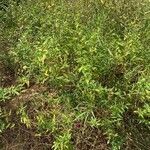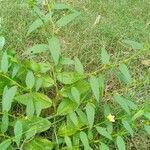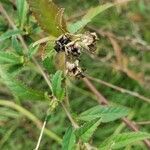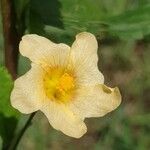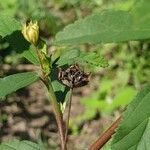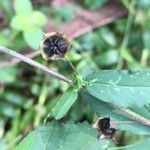Annual or biennial herb or suffrutex or shrublet, up to c. 1 m tall; erect, often ± virgate, usually not much branched; stems terete, grey or brown, stellate-pubescent to stellate-tomentose, ultimately glabrescent. Leaf-lamina 2-6 x 0.5-2.5 cm, oblong to lanceolate-oblong or somewhat rhomboid, shortly and sparsely stellate-pubescent or almost glabrous on the darker upper surface, shortly stellate-pubescent to velutinous on the pale lower surface, apex usually obtuse to rounded or rarely acute, margin finely crenate or subserrate, base broadly cuneate to rounded; petiole usually less than 5 mm long; stipules c. 5. mm long. Flowers pale yellow to cream, axillary, solitary; pedicels rarely exceeding 20 mm long in flower and 35 mm long in fruit. Calyx 4-5 mm long, saucer-to cup-shaped, divided to about 1/3, stellate-velutinous or more sparsely pubescent, 10-nerved; lobes triangular, acute, sometimes mucronate. Petals c. 8 mm long. Staminal tube glabrous or sparsely glandular-papillose. Mericarps 8-12, c. 4 mm long, birostrate, with awns usually connivent until dehiscence of the fruit, glabrous except for the usually shortly pubescent awns. Seeds smooth and glabrous except for the pubescent area around the hilum.
Subshrubs erect or prostrate, many branched, to ca. 1 m tall. Branchlets stellate. Stipules spinelike, 3-5 mm; petiole 2-5(-8) mm, stellate puberulent; leaf blade rhombic to oblong-lanceolate or obovate, rarely linear-lanceolate, 1-4.5 × 0.6-2 cm, abaxially gray-white stellate pilose, adaxially sparsely stellate pilose to subglabrous, base broadly cuneate, margin dentate, apex obtuse to acute. Flowers solitary, axillary. Pedicel 1-2.5 cm, densely stellate tomentose, articulate above middle. Calyx cup-shaped, 4-5 mm, abaxially stellate pubescent, lobes triangular, apices acute. Corolla ca. 1 cm in diam.; petals yellow, obovate, ca. 8 mm, base attenuate, apex rounded. Filament tube 4-5 mm, glabrous. Style branches 8-10. Fruit semiglobose to broadly turbinate, 6-7 mm in diam.; mericarps 7-10, 2.5-3 mm excluding awn, shallowly grooved to near base, eventually dehiscent, side walls usually thin, not veined, stellate puberulent, apex usually (1 or)2-awned, awns to 1.5 mm. Seeds reniform, ca. 2 mm, blackish. Fl. autumn-winter.
Subshrubs, 1 m. Stems erect, stellate-puberulent, hairs to 0.1 mm. Leaves: stipules free from petiole, 1-veined, subulate, 5–6 mm, subequal to petiole; petiole 5–7 mm, 1/10–1/4 length of blade, stellate-puberulent; blade ± rhombic, 2.5–9 cm, smaller distally, 2–3(–4) times longer than wide, base usually cuneate, sometimes somewhat truncate to subcordate, margins serrate distally, entire basally, apex acute to subobtuse, surfaces stellate-puberulent or glabrescent adaxially. Inflorescences axillary solitary flowers. Pedicels slender, (1–)3–4 cm, 4–6 times length of calyx, much shorter than to ± equaling subtending leaf, at least distalmost. Flowers: calyx ribbed, 5–6 mm, puberulent, lobes ovate; petals yellow, 7–9 mm; staminal column hairy; style 10–14-branched. Schizocarps subconic, 4–5 mm diam., glabrous; mericarps 10–14, 3–4 mm, laterally reticulate, apex muticous to spined, sometimes 1-spined through failure of dehiscence, glabrous. 2n = 14, 28.
Bushy annual up to 1 m high, becoming very woody towards base and developing a long root. Stems moderately clothed in fine stellate hairs when young, becoming glabrous when older. Lvs densely clothed in stellate hairs below, moderately clothed in stellate hairs above, often becoming ± glabrous above when older, rhombic to oblong, obtuse at apex, not lobed, serrate except near base, 10-30-(60) mm long; petioles 1-5-(8) mm long; stipules linear, 3-5 mm long. Fls axillary and solitary, often appearing clustered among lvs in short axillary branches; fruiting pedicels 10-25-(30) mm long; calyx campanulate, clothed in very fine stellate hairs with 10 thickened nerves toward base; calyx teeth ovate-triangular, acuminate, < tube; petals pale yellow to orange, 3-8 mm long. Mericarps 8-12 per fr., glabrous, ± smooth on back, inner edges shortly awned, indehiscent.
Arrowleaf sida, Pretoria sida, Queensland hemp; taaiman (A); ivivane (Swati) Annual, biennial suffrutex, 0.1-1.5 m high; erect, ± virgate. Leaves oblong to rhomboid, apex obtuse, base cuneate or rounded, margins finely crenate-serrate; upper surface dark green, lower surface paler, shortly stellate-pubescent to velutinous. Flowers axillary, solitary; pedicels up to 20 mm long in flower, 35 mm in fruit. Epicalyx 0. Calyx saucer-or cup-shaped, triangularly lobed to ± 1/3 length, 10-nerved. Petals pale yellow to cream-coloured. Flowering time all year. Fruit a schizocarp. Mericarps 8-12, distinctly birostrate with Sub-Erect, often connivent awns, nearly glabrous. Seeds smooth, glabrous.
Branching annual (in our range) to 1 m; lvs oblong to ovate or rhombic, 2–6 cm, crenate chiefly beyond the middle; cal thinly stellate; pet pale yellow, 4–8 mm; carpels commonly 10, each tipped by a single erect, subulate beak grooved longitudinally and split into two at dehiscence; 2n=14, 28. A weed in waste places and along roads; pantropical, n. occasionally to se. Va., and as a ballast-waif farther n. All summer.
Leaf-lamina 2–6 × 0·5–2·5 cm., oblong to lanceolate-oblong or somewhat rhomboid, shortly and sparsely stellate-pubescent or almost glabrous on the darker upper surface, shortly stellate-pubescent to velutinous on the pale lower surface, apex usually obtuse to rounded or rarely acute, margin finely crenate or subserrate, base broadly cuneate to rounded; petiole usually less than 5 mm. long; stipules c. 5. mm. long.
A herb or small shrub. It grows 1-1.5 m tall. It is very hairy. It has many branches. The leaf stalk is 3-5 mm long. The leaf blade is sword shaped and 2.2-4.5 cm long by 0.6-2 cm wide. The flowers occur singly in the axils of leaves. They are yellow and about 1 cm across. The fruit is half round and 6-7 mm across.
Annual or biennial herb or suffrutex or shrublet, up to c. 1 m. tall; erect, often ± virgate, usually not much branched; stems terete, grey or brown, stellate-pubescent to stellate-tomentose, ultimately glabrescent.
Requiring further taxonomical study throughout its range.There appear to be three varieties in our area: — Sida rhombifolia var. α, Sida rhombifolia var. β and Sida rhombifolia var. γ
Annual or biennial herb or shrub, up to 1 m high. Leaves discolorous, rhomboid. Mericarps with 2 distinct suberect connivent awns, glabrous. Flowers pale yellow to cream.
Calyx 4–5 mm. long, saucer-to cup-shaped, divided to about 1/3, stellate-velutinous or more sparsely pubescent, 10-nerved; lobes triangular, acute, sometimes mucronate.
Mericarps 8–12, c. 4 mm. long, birostrate, with awns usually connivent until dehiscence of the fruit, glabrous except for the usually shortly pubescent awns.
Flowers pale yellow to cream, axillary, solitary; pedicels rarely exceeding 20 mm. long in flower and 35 mm. long in fruit.
Seeds smooth and glabrous except for the pubescent area around the hilum.
Staminal tube glabrous or sparsely glandular-papillose.
A widespread perennial weed
Petals c. 8 mm. long.
